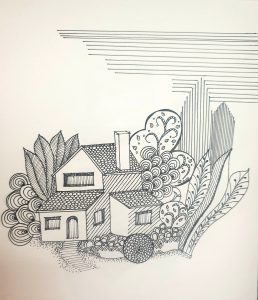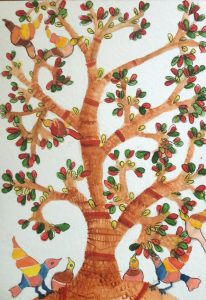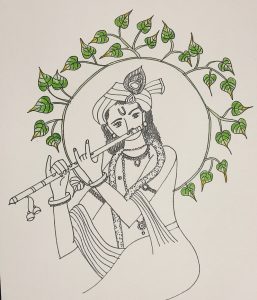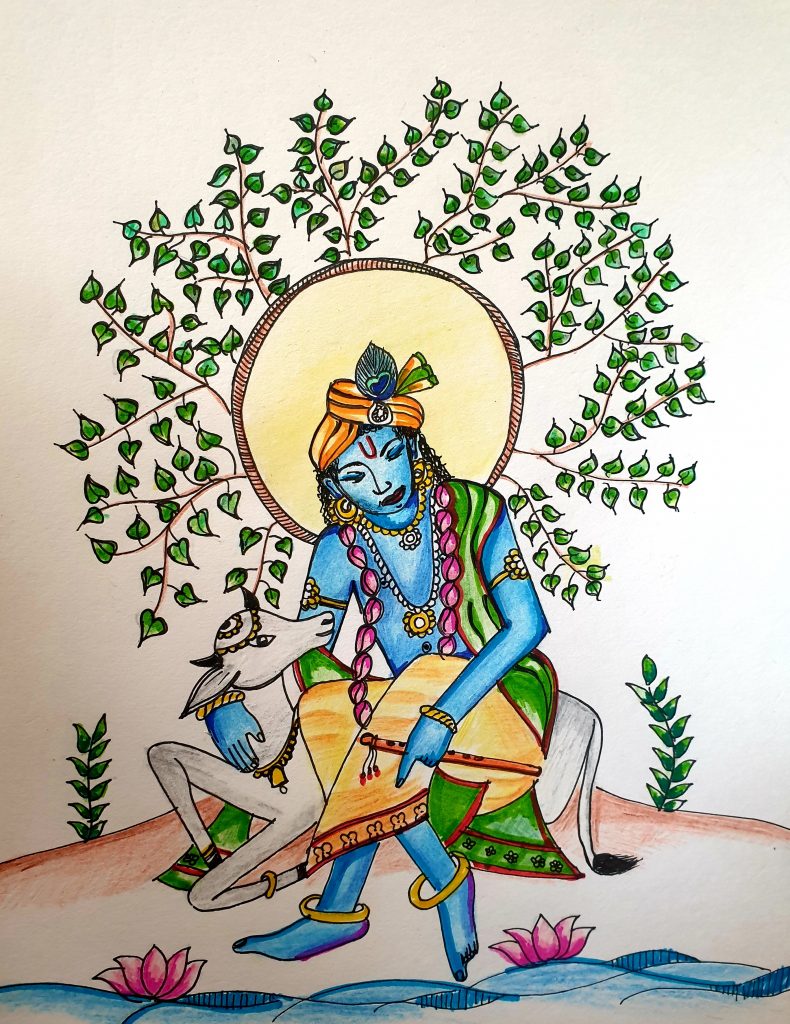As I sit at my desk trying to write, my attention is caught by a rustling peepal tree . In the blazing hot afternoon, amongst all the exhausted trees I can see a peepal tree glistening and dancing to its own song. Maybe that’s why Lord Krishna in the Bhagavad Gita said:
aśhvatthaḥ sarva-vṛikṣhāṇāṁ devarṣhīṇāṁ cha nāradaḥ
gandharvāṇāṁ chitrarathaḥ siddhānāṁ kapilo muniḥ
Amongst trees I am the peepal tree
Of the celestial sages – I am narada
Amongst the Gandharva – I am Chitraratha
And of all those who are perfected – Kapila muni
Trees and plants for long have been held sacred to communities throughout the world. The worship of trees and plants i s an ancient phenomenon in India and they feature in our myths, epics, rituals, worship and daily life. Tree worship was a result of man’s natural reverence for a creation of nature that provided him food, shelter, timber and much more. By conferring sanctity on trees, the ancient people indicated their appreciation of their socio-economic-medicinal role. Trees were more than ordinary creations and represented life itself. Most temples , towns, villages and sometimes even Sikh temples and muslim Dargahs are associated with trees. Some trees are sacred to the individual deity, while others are sacred to the place. There are many places that are named after sacred plants like Vrindavan (forest of the Vrinda –tulasi plant), Kanchipuram (town of the Kanchi – river portia tree).
s an ancient phenomenon in India and they feature in our myths, epics, rituals, worship and daily life. Tree worship was a result of man’s natural reverence for a creation of nature that provided him food, shelter, timber and much more. By conferring sanctity on trees, the ancient people indicated their appreciation of their socio-economic-medicinal role. Trees were more than ordinary creations and represented life itself. Most temples , towns, villages and sometimes even Sikh temples and muslim Dargahs are associated with trees. Some trees are sacred to the individual deity, while others are sacred to the place. There are many places that are named after sacred plants like Vrindavan (forest of the Vrinda –tulasi plant), Kanchipuram (town of the Kanchi – river portia tree).
Trees are found in cave paintings, the terracotta seals in the Indus civilization and even the Aryans of the early vedic period were found to be the worshippers of nature. According to the Ramayana, there were several types of sacred trees like tulasi, peepal, banyan and Indian gooseberry.
The Mahabharata says that holy trees should not be injured as they are the abodes of Devas, Yakshas, Rakshasas and so on. The Rigveda says that the plants are “those that grew in the old times…much earlier than even the shining ones (devas)… and are different from many different places… plants were a source of energy, with healing powers, and personified the divine.”
It is mentioned in the Ramayana that when Ravana abducted Seeta, Rama laments for Seeta’s separation. He starts searching for her and goes on asking every plant, tree and animal, in a kind of frenzied attitude. Over here the forest shows a great deal of empathy as the feverish Rama searches for Seeta. Rama enquires while hugging every tree and plant from Kadamba, Bilva, Ashoka and Karnikara for his beloved Seeta. He, in a state of distress, turns towards trees for support.Our ancestors had knowledge regarding the healing energies of the trees. The earliest temples were simply images placed under trees. Later, the tree and the image were enclosed by a fence made of wood, followed later by stone. The temple building itself was a much later construction.
In vAstu shastra, climatology, that is the direction of the sun, wind and rain play an important role. vAstu advises us on how to create an environment in which we feel comfortable and supported. Below are some collected information, guiding towards the tree plantation as per the mention in various texts:

- vAstu specifies which trees and plants are preferred in a particular direction of a house and also specifies the ones which are not preferred are the house.
- Agni purana, Matsya purana, Garga Samhita, vAstu pradeep, Vrikshayurveda talk in detail regarding plantation
- Agni deva (in Agni purana) states Plaksha in north, Amla in north east, Banyan in east, Pomegranate in southeast, Audumbar in South, Tamarind in southwest, Ashwattha (peepal) in west and Bilva in northwest are considered auspicious, even lord Dhanvantari accepts this.
- Bhagwan Garg says, “Avoid peepal in east, avoid Plaksha in south, avoid Banyan in west and avoid Audumbar in North.” This means that specific trees are preferred in specific directions.
- Thorny trees and plants (the only exception is the rose and Patri used in Pooja), sappy milky trees are considered inauspicious (not good for females and children).
- Trees which can be planted in any direction are Punnaga,, Neem, Pomegranate, Ashoka trees, Nagkesar, flowering plants, Japakusum, Kesar, Jayanti, Chandan, Aparajit, Bilva, Mango, Dalchini, Nagar, Coconut etc.
- Plant the fruit trees separately and avoid using wood from fruit trees.
- If a tree falls exactly in front of the main gate then it creates what is called as Dwarvedha and to avoid that it is suggested to shift the entrance accordingly, so as to not have the shade of a fully grown tree fall directly on the main gate.
- Hibiscus is good in the north, east and west. Avoid planting it in the southeast.
- Trees and plants which are auspicious and grow lakshmi are – Plaksha, Shami, Shreephala (coconut), Shreeparni and lotus.
- Drumstick trees can be anywhere planted in the house plot.
- Christmas tree and almond tree can be planted in the southwest
- South and west could be covered with tall and huge trees for shade.
- Tulasi vrindavan can be planted in northeast, brahmasthana (Center of the house), southwest .
- Astrology specific trees are ‘Aaradhya Vrikshas’ (each nakshatra has a specific Aradhya tree). According to nakshatras one could do the worship of their respective trees or plants.
What to do if certain trees are planted in a non-preferable direction?
The advisable option is to plant other direction- preferred trees near those trees.

Endowed with Earth and universal life force energy, trees are the most spiritually advanced living beings on Earth. Trees areconstantly in a meditative state. Besides converting carbon dioxide into oxygen, trees absorb negative energy. They help open your energy channel. This is the reason why sitting under a tree or living in the presence of trees feels so good. It’s the energy inside the tree that vibrates and the healing begins to make you feel peaceful, safe, secure and stable.
“If we surrender to earth’s intelligence we could rise up rooted, like trees”
– Rainer Maria Rilke
Article By: Ar. Madhura Modi
Sketches by: Ar. Madhura Modi & Ar. Shivangi Gadia



 Priya is a Yoga therapist in the Krishnamacharya tradition. She adapts Reiki & energy work, Vedic chanting, life coaching & Ayurvedic practices in her healing spaces. She is committed to nurturing collectives that have the praxis of Yoga at their heart.
Priya is a Yoga therapist in the Krishnamacharya tradition. She adapts Reiki & energy work, Vedic chanting, life coaching & Ayurvedic practices in her healing spaces. She is committed to nurturing collectives that have the praxis of Yoga at their heart. Anisha has been on an exploration to understand herself through yoga for the last 15years which led her to teaching yoga, yoga therapy and inner work through yoga.
Anisha has been on an exploration to understand herself through yoga for the last 15years which led her to teaching yoga, yoga therapy and inner work through yoga. Apoorva chanced upon Yoga in her early 20s. A spark was lit within and there was no turning back. Her exploration led her to the Krishnamacharya tradition more than a decade ago. Curious about human behaviour and what drives it, she was thrilled when her search ended (and also began) when she first came upon the Yoga Sutra, which illuminated a path towards answering many questions that had been held for a long time.
Apoorva chanced upon Yoga in her early 20s. A spark was lit within and there was no turning back. Her exploration led her to the Krishnamacharya tradition more than a decade ago. Curious about human behaviour and what drives it, she was thrilled when her search ended (and also began) when she first came upon the Yoga Sutra, which illuminated a path towards answering many questions that had been held for a long time. Anita is a yoga teacher and therapist in the tradition of Sri.T.Krishnamacarya and Sri T.K.V. Desikachar, a Reiki practitioner and a Life Coach. She is also the founder of Vishoka, a center for learning Indic and energy-based frameworks for living and healing. Her deep concern for human suffering and the problems of unsustainable living kept her on the path of seeking an integrated approach to looking at life, living, learning and healing.
Anita is a yoga teacher and therapist in the tradition of Sri.T.Krishnamacarya and Sri T.K.V. Desikachar, a Reiki practitioner and a Life Coach. She is also the founder of Vishoka, a center for learning Indic and energy-based frameworks for living and healing. Her deep concern for human suffering and the problems of unsustainable living kept her on the path of seeking an integrated approach to looking at life, living, learning and healing. Ankit is a seeker in the wisdom traditions of India. The core of his work includes creating dialogic spaces where people can look within and see the connection between their inner and outer lives. Inspired by the likes of Gandhi, Aurobindo, Vivekananda and Guru Gobind his experiments in service took him back to his roots in Punjab where he is creating a community-led model of higher education which is open, inclusive and accessible for all. Ritambhara for him is a space for engaging in a community which is committed to a DHramic life. He anchors his work of learning and leadership in the Antaranga Yoga Sadhana and the humanistic wisdom of Mahabharata.
Ankit is a seeker in the wisdom traditions of India. The core of his work includes creating dialogic spaces where people can look within and see the connection between their inner and outer lives. Inspired by the likes of Gandhi, Aurobindo, Vivekananda and Guru Gobind his experiments in service took him back to his roots in Punjab where he is creating a community-led model of higher education which is open, inclusive and accessible for all. Ritambhara for him is a space for engaging in a community which is committed to a DHramic life. He anchors his work of learning and leadership in the Antaranga Yoga Sadhana and the humanistic wisdom of Mahabharata.
Can you please share the scientific name for the trees mentioned above to avoid selecting the wrong tree. When we search for some trees names online, we are unable to find the regional names for them.